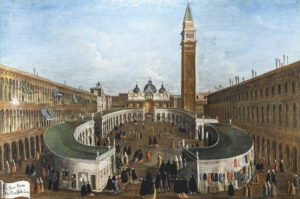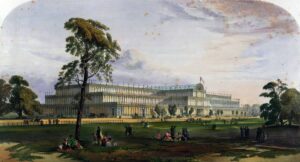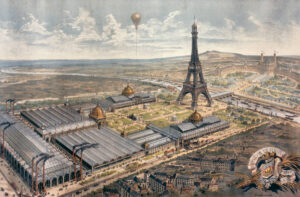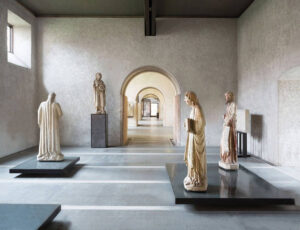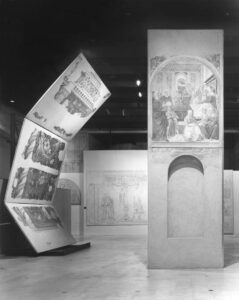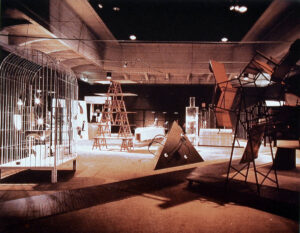parole e idee all’inizio delle pillole
terminology: terms and concepts to set the stage for the clips
Dopo aver pubblicato più di metà delle clip, al primo tentativo di tentarne una traduzione in francese e in inglese, è emersa la necessità di chiarire il significato di alcune parole.
1. mostra, allestimento, luogo.
Altrove, in questo sito, il complesso -e spesso dimenticato- significato di ognuna di queste tre parole italiane viene indagato a partire da ragionamenti intorno alla loro etimologia. (link)
Qui di seguito precisiamo questo significato in relazione all’oggetto delle nostre riflessioni: l’allestimento di mostre.
Non è difficile definire cosa intendiamo per mostra.
Con la parola mostra intendiamo qualsiasi tipologia di esposizione, ivi comprese le vetrine, gli showroom, gli stand e i padiglioni fieristici, le sale dei musei. Tuttavia, al centro della nostra attenzione è in particolare la mostra temporanea, poiché nel suo paradigma sembra raccogliere i temi e i problemi di tutti gli altri modi e luoghi dell’esporre.
E’ meno facile parlare di allestimento.
Prima di tutto, occorre ammettere che per la maggior parte delle persone non è molto chiaro in che cosa consista realmente l’allestimento di una mostra.
Ma la difficoltà a parlare di allestimento diventa quasi insormontabile non appena si tenti la sua traduzione.
Sembra che non esista un esatto corrispettivo di questo termine né in inglese, né in francese, né in tedesco.
E il problema non è soltanto di terminologia.
Un esempio può aiutarci.
In francese -lingua a noi più affine- a seconda dei contesti e degli autori, per allestimento si trovano molte parole diverse: accrochage, décor, aménagement, scénographie, mise en scéne, …
Ma l’allestimento non è un accrochage, poiché non è l’azione con la quale si attaccano dei quadri a una parete.
Non è nemmeno un décor, poiché non è riducibile ad un problema di eleganza o di buon gusto.
Non va bene neanche aménagement, nonostante la complessità di significati che il termine riassume, poiché l’allestimento non ha nulla in comune con l’arredamento di una casa o con l’assetto di un territorio.
Non è una scénographie, poiché l’allestimento non è la predisposizione della scena -o la scena stessa- nella quale si svolge l’azione dei personaggi. I personaggi -i protagonisti- di una mostra sono i visitatori e gli oggetti esposti: come poi vedremo nelle clip, è propriamente l’allestimento che determina le loro azioni, le loro relazioni reciproche.
L’allestimento potrebbe invece essere qualcosa di simile alla mise en scéne, se per scena intendessimo un’azione, ossia un scénario. Ma allora un termine più aderente potrebbe essere regìa -in francese direction-, come quella di un film. Ma è evidente che l’allestimento è qualcosa di totalmente differente…
A quanto pare, non mancano le parole. Il problema è che se in una lingua corrente manca una parola, in realtà manca l’idea, o forse addirittura la nozione di ciò che la parola designa. Nel nostro caso manca ciò che la parola allestimento significa.
Dunque è necessario chiarire cosa significhi la parola allestimento quando parliamo di mostre.
Con la parola italiana allestimento definiamo il processo -e il risultato del processo- con il quale il curatore e l’allestitore di una mostra configurano l’esperienza che il visitatore farà delle cose -o delle idee- mostrate.
Il progetto dell’allestimento di una mostra è il progetto dell’esperienza che il visitatore farà delle cose o delle idee esposte.
A prima vista può sembrare qualcosa di strano o di mai visto. A ben vedere, però, la configurazione di un’esperienza è propriamente l’obiettivo che hanno sempre perseguito i grandi allestimenti, a cominciare dalle fiere universali dell’800. (link)
Non è nemmeno strano che la parola sia italiana, poiché è probabilmente in Italia, durante il ventennio fascista, che si afferma platealmente la ricerca di questo obiettivo e l’esercizio consapevole e mirato dell’allestimento di mostre.
E, infine, il luogo.
Nelle clip parleremo spesso di luogo ospite -intendendo la sede che ospita la mostra- e di luogo della mostra o di luogo dell’allestimento -intendendo con queste espressioni l’intera struttura espositiva, ossia l’insieme indissolubile composto dagli oggetti esposti, dai loro supporti e dagli spazi in cui sono esposti-.
Anche l’espressione luogo della mostra può sembrare misteriosa, ma è centrale nella progettazione di un allestimento espositivo. Diventa perfettamente chiara non appena si pensi a cosa è un luogo e se ne applichi l’idea alla mostra.
Il luogo è uno spazio delimitato che siamo in grado di riconoscere e di ricordare per le sue caratteristiche: ossia per lo specifico sistema di relazioni -per l’ordine- che lega tutte le sue parti e che lo distingue dal resto del mondo.
2. organizzatore, curatore, allestitore
In astratto, gli operatori coinvolti nella realizzazione di una mostra sono tre: l’organizzatore, il curatore, l’allestitore.
In concreto, questi operatori -queste figure logiche, cui corrispondono altrettanti ruoli- possono variamente sovrapporsi nella stessa persona o moltiplicarsi, dando allora luogo a più articolati gruppi di lavoro.
Il perché di una mostra è legato al per chi. L’organizzatore -chi fornisce i mezzi finanziari e gli apparati operativi e logistici- concepisce la produzione di una mostra come l’oggetto di un investimento da cui attende risultati esterni sotto forma di benefici diversi e del quale è in ultima analisi il principale responsabile.
Per essere più precisi, l’organizzatore si aspetta un ritorno ‘economico’: ovviamente, non si tratta solo dei biglietti d’ingresso -che possono perfino non esserci-, quanto -soprattutto- della promozione di un marchio, di un prodotto, o della conoscenza, della cultura, o del consenso politico, dell’indotto turistico…
Le finalità e i mezzi dell’organizzatore si presentano agli altri operatori come le condizioni, quindi i vincoli e le possibilità con i quali progetto e realizzazione della mostra si devono confrontare.
Il cosa e il come mostrare rimandano agli ambiti di lavoro autonomi, ma qui inseparabili, del curatore e dell’allestitore, relatori ed esperti rispettivamente della materia da mostrare e delle tecniche del mostrare.
…………………………………………………………………………………………….
![]()
After having published more than half of the clips, our first attempt at a translation into French and English revealed the need to clarify the meaning of certain terms.
1. mostra, allestimento, luogo / exhibition, staging, site
Elsewhere in this site, the complex -and often forgotten- significance of each of these three terms is elucidated by inquiring into their etymology. (link)
Here, we explain their meaning in relation to the purpose of our reflection: the allestimento -or staging– of an exhibition.
It is not difficult to define what we mean by mostra.
By the Italian word mostra, we mean any type of exhibition, including shop windows, showrooms, stands and exhibition pavilions, museum halls. However, the focus or our attention is the temporary exhibition because in its paradigm it seems to gather the themes and problems of all other methods and places of exhibiting.
It is more difficult to explain allestimento, what we will translate as staging.
First of all, it must be admitted that for most people it is not very clear what the allestimento -the staging of an exhibition- really consists of. But the difficulty of talking about this term becomes almost insurmountable as soon as you try its translation: it seems that there is no an exact equivalent of this term in English, French or German.
And the problem is not just one of terminology.
An example may help.
In French -the language closest to us- depending on the contexts and the authors, there are many different terms for allestimento: accrochage, décor, aménagement, scénographie, mise en scéne, …
But, the allestimento is not accrochage, which refers to the action of attaching paintings to a wall.
Nor is it a décor, since the term is not reducible to a question of elegance or good taste.
It is not good even aménagement, despite the complexity of meanings that the term sums up, since the allestimento has nothing in common with furnishing a house or with the planning of a territory.
Nor does aménagement offer an adequate meaning, despite the many meanings that the term encompasses. Allestimento has nothing in common with the furnishing or décor of a house, or with the planning of a territory.
It is not a scénographie, because allestimento is not the preparation of a scene -or the scene itself- in which the actors perform. The actors -the protagonists- of an exhibition are the visitors and the objects exhibited. As we will see in the clips, it is precisely the allestimento that determines their actions, their relations with each other.
The allestimento can instead be, sometimes, something similar to the mise en scéne, if by scéne we mean an action ant its scénario, in the meaning of ‘situation’: and in this sense that, at times, we can use the French expression.
Also in English, as in French, the nearest expression comes from the jargon of the theater people: so, if the translation of scéne is stage, then the translation of mise en scéne is staging.
And for this reason -as we have already pointed out- we will translate the Italian word allestimento with staging of an exhibition.
So, there seems to be no shortage of possible expressions to use. The -implicit- problem is another: it is that if a word does not exist in a given language, the reality is that the idea itself is missing, or perhaps even the notion of what the word refers to.
In our case the meaning of the word allestimento is missing.
For this reason, we must clarify what is meant by allestimento when we speak about exhibitions.
We use the term allestimento or, in English, staging, to mean the process -and the result of the process- by which the curator and the staging designer of an exhibition design the experience which the visitor will have in relation to the objects or events exhibited.
The design of the staging of an exhibition is the design of the visitor’s experience of the objects or events exhibited.
At first glance, this definition may seem strange or may appear to be something never observed. Looking more closely, however, the design for an experience is specifically the goal that all the Great Exhibitions -and their stagings- have pursued, starting with the World Fairs of the 1800s (link)
Nor is it strange that the word is Italian, since is probably in Italy, during the twenty years of Fascism, that the awareness of the exceptional effectiveness of the staging of the exhibitions within the framework of the ‘cultural policy’ of the regime appears clear, and that the search for that goal -to guide the visitor experience- becomes systematic an institutional.
And finally, the term luogo, or what we translate as site.
In the clips we will often speak of luogo ospite (or host site) -meaning the place where the exhibition is hosted- and of luogo della mostra or luogo dell’allestimento (or exhibition site) -meaning the entire structure of the exhibition, or rather, the indivisible ensemble comprised of the exhibited objects, their supports and the place in which they are exhibited.
The expression luogo della mostra or exhibition site may seem mysterious, but it is central to the project for the staging of an exhibition. This becomes perfectly clear as soon as one thinks about what is a site and applies it to the idea of an exhibition.
The site is a delimited space that we can recognize and remember by its characteristics: or rather for the specific system of interrelations -by its order- that links all of its parts and that is distinguishable from the rest of the world.
2. organizzatore, curatore, allestitore / organizer), curator, staging designer
In the abstract, the parties involved in the realization of an exhibition are three: the organizer, the curator and the staging designer.
Concretely these different roles may be assumed by a single person; or by different parties, giving rise in such case to a working group.
The why of an exhibition is linked to the whom. The organizer, who provides the financial means and the operating and logistical systems, conceives the production of an exhibition as the object of an investment from which an external result is expected in the form of diverse benefits. In the final analysis, the organizer is the party principally responsible for the exhibition.
To be more precise, the organizer expects an ‘economic’ return. Obviously, this is not limited to the returns from entry fees -which may not even be charged- but rather, and more importantly, from the promotion of a brand, or a product, or of knowledge, culture or of political consensus or of increased tourism…
The aims and means of the organizer appear to the other parties involved in the preparation of an exhibition as the conditions, in other words, the commitments and possibilities with which the project and realization of the exhibition must contend.
The what and the how to exhibit refer to the autonomous, but here inseparable, work of the curator and the staging designer, proponents and experts, respectively, of the material to be exhibited and of the technique used in exhibiting.
0.1 Gabriel Bella, Antica Fiera della Sensa, 1779-1792
https://www.meisterdrucke.uk/fine-art-prints/Gabriele-Bella/290443/The-Antique-Fair-of-Sensa,-Venice-(set-with-60938-and-60789).html
https://www.topipittori.it/it/topipittori/i-regni-dellimmagine-4-venezia-volo-duccello
https://www.copia-di-arte.com/a/bella-gabriele/the-antique-fair-of-sensa.html
0.2 il Crystal Palace a Hyde park, vista da nord-est
https://it.wikipedia.org/wiki/Crystal_Palace_(palazzo)#/media/File:Crystal_Palace_from_the_northeast_from_Dickinson’s_Comprehensive_Pictures_of_the_Great_Exhibition_of_1851._1854.jpg
Pubblico dominio
0.3 Paris, Exposition Universelle, 1889
https://www.toureiffel.paris/fr/le-monument/exposition-universelle
0.4 Mostra dell’Aeronautica, Palazzo dell’Arte, Milano 1934 – Giò Ponti, sala de Il più leggero dell’aria,
Foto Crimella
http://archivio.triennale.org/archivio-fotografico/esposizione/21846-aer
0.5 Carlo Scarpa, Museo di Castelvecchio, Verona (1958-1975) – Galleria delle Sculture
seconda sala
0.6 Carlo Scarpa, mostra itinerante Frescoes from Florence – allestimento alla Hayward Gallery, Londra, 1969
ph. Chorley, Hyman & Rose Ltd.
Foto del Fondo Maria Vittoria Lodovichi/Foto e Documentazione Eventi, fascicolo 591, Fototeca Associazione Archivio Storico Olivetti, Ivrea
0.7 Achille Castiglioni, mostra Du Design au ready-made, Centre Pompidou, Parigi 1985
courtesy by Achille Castiglioni
0.8 Maurizio Cattelan, Novecento, 1997
https://www.turismotorino.org/it/esperienze/cultura/Residenza%20Reale/castello-di-rivoli-museo-darte-contemporanea
